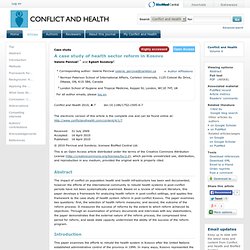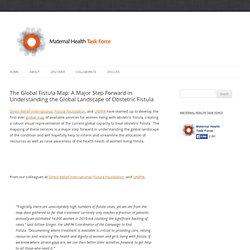

A case study of health sector reform in Kosovo. Above, the paper presented a framework for analyzing health care reform in a post-conflict setting.

Below, we apply that framework to Kosovo, beginning with an overview of how the health context - both health infrastructure and population health problems, combined with external pressure for health reform to shape the selection of health reform measures. We then overview the health reform program, and outline the progress made toward implementing those reform measures. In applying this framework to Kosovo, the paper outlines how the post-conflict political context and weak government capacity combined to undermine progress on health reform. Health Context: The Health System After the war, the parallel Mother Theresa Network was virtually abandoned. The health system had been seriously weakened by the years of political and economic turmoil and by several months of conflict. Health clinics in rural areas suffered from an acute lack of personnel and equipment. External Pressures for Reform. Demographics of Kosovo. The demographic features of the population of Kosovo, includes various factors such as population density, ethnicity, education level, health of the populace, economic status, religious affiliations and other aspects of the population.

The dominant ethnic group is Albanian, with significant minorities of Serbs and others. The final results of the 2011 Census recorded Kosovo as having a population of 1,739,825 (excluding North Kosovo).[1] Population[edit] The 2000 Living Standard Measurement Survey by Statistical Office of Kosovo (rejected by Belgrade[2]): Total population estimated between 1.8-2.0 million.[3] From 2000, AMSJ (confirmed by Kosovo Statistical Office in 2003), estimating a 1,900,000 strong population. Vital statistics[edit] In 2009 in Kosovo were registered 34,477 births, 34,240 of them were born alive, while 237 were born dead.[4] The vitality ratio (ratio between live births and total deaths) was 9. VITAL PHENOMENA IN KOSOVO ACCORDING TO YEAR 2002 - 2011 result Cities[edit] About a restoration of the health system in Kosovo. Parasitic Diseases. Schistosomiasis Disease Burden Schistosomiasis, also known as bilharziasis, is second only to malaria in public health importance.

It is estimated that 200 million people worldwide are infected with the snail-transmitted, water-borne parasitic helminth, and that 20 000 deaths are associated with the severe consequences of infection, including bladder cancer or renal failure (Schistosoma haematobium) and liver fibrosis and portal hypertension (S. mansoni). In sub-Saharan Africa where schistosomiasis constitutes an important public health problem, a survey in 2000 of disease-specific mortality reported that 70 million individuals out of 682 million had experienced haematuria and 32 million dysuria associated with S. haematobium infection. It was estimated that 18 million suffered bladder wall pathology and 10 million hydronephrosis. High rates of schistosomiasis occur near bodies of fresh water.
Parasitology Vaccine. All Statistics. The World Bank. KOICA 홈페이지. 한국국제보건학생연합회, KOSAG. eHRAF World Cultures. The Global Fistula Map: A Major Step Forward in Understanding the Global Landscape of Obstetric Fistula. Direct Relief International, Fistula Foundation, and UNFPA have teamed up to develop the first-ever global map of available services for women living with obstetric fistula, creating a robust visual representation of the current global capacity to treat obstetric fistula.

The mapping of these services is a major step forward in understanding the global landscape of the condition and will hopefully help to inform and streamline the allocation of resources as well as raise awareness of the health needs of women living fistula. From our colleagues at Direct Relief International, Fistula Foundation, and UNFPA: “Tragically, there are unacceptably high numbers of fistula cases, yet we see from the map data gathered so far that treatment currently only reaches a fraction of patients annually-an estimated 14,000 women in 2010-not counting the significant backlog of cases,” said Gillian Slinger, the UNFPA Coordinator of the Campaign to End Fistula.
Read the full press release here. Like this: